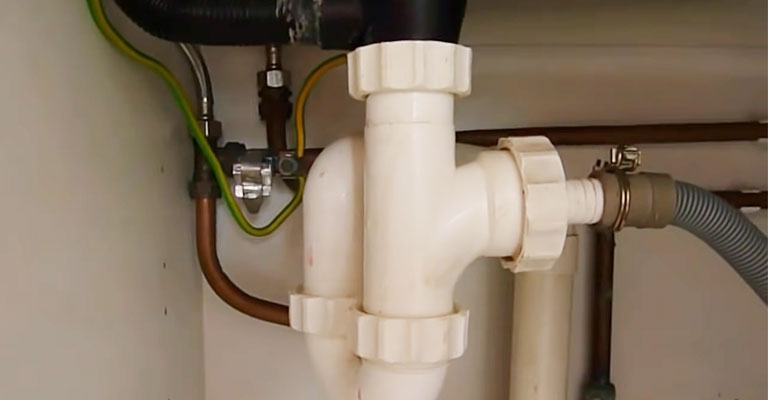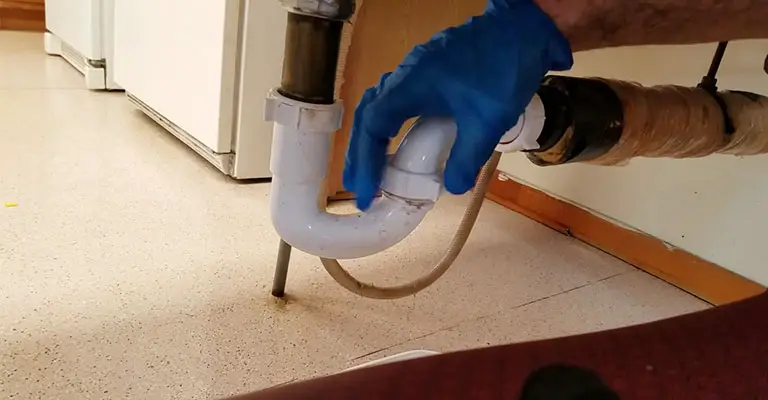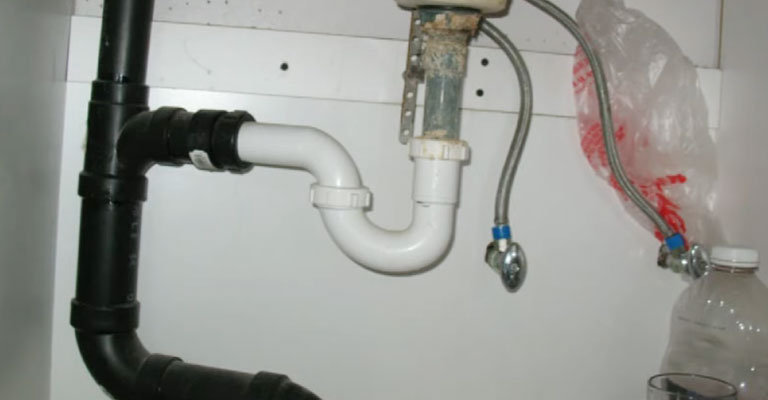Laundry rooms often share drains with sinks. For example, if the laundry room is next to the kitchen, the kitchen sink may serve as the drain for the washing machine.
Both drains can empty into toilet waste lines and be vented through these waste lines. This method is called wet venting by plumbers.
It’s either something preventing water from flowing or air from getting in that causes the sink to back up when the washing machine is draining.
Here’s What’s Probably Going On
In addition to the washing machine and sink, you most likely have a toilet waste line that drains into the drains. However, you won’t know for sure until you uncover the walls to inspect the drain connections.
Plumbers sometimes oversize waste lines in this configuration to allow air to pass while water is flowing. The restriction of airflow and slow water flow occurs if a partial blockage occurs.
A large volume of water in the washing machine is actively pumped into the pipes, so you might not notice the slow flow until the washing machine drains.
What Happens If The Washing Machine Drains Into The Sink?
Washing machines and utility sinks can share a drain, so there’s no harm. The common draining system for utility sinks and washing machines allows them to drain to the sewer line.
You must understand how the washing machine drains into the sink and why it is backing up. It is possible to fix the problem once you have identified the cause so that your washing machine and sink drain smoothly.

Washing Machine Drains Into Sink | Exploring The Possibilities
Do you have a washing machine in your basement without a drainage system? If you want to drain it differently, you can do so. For example, connecting a utility sink to a washing machine can be done with a hose.
Consequently, the washing machine drains into the same plumbing system as the sink. In most cases, there are two causes of a malfunctioning drain hose from a washing machine to a sink.
First, this is caused by improper venting and blockages inside the pipes. Therefore, you must examine the draining system to determine the cause.
If the water flow is restricted due to a blockage, you may need to use a plunger to clear the clog.

Installing A Plumbing System That Connects The Sink Drain And The Washing Machine Drain
The hose you need for this purpose is a special one. In addition, the distance between the sink and the appliance will play a role. Here are some options you may consider when searching for a washing machine drain hose to sink.
Would you like to connect your washing machine to your sink with the ultimate drain hose?
It is therefore recommended that you select a stainless-steel braided washing hose. Its ability to drain larger washing machines makes it perfectly suited for the job.
An affordable alternative is the rubber drain hose. This device can connect your washer to your main drain or utility sink. To strengthen rubber drain hoses, newer versions have braided mesh or rayon.
You must also secure the hose when connecting the sink and washing machine. Wire ties should be positioned at the backside of the sink to secure the drain hose from your washing machine.
Alternatively, you can install traditional brackets. It is possible to install a homemade filter at the end of the drain hose to prevent it from getting clogged and backing up.
Despite this, the hose may still back up and overflow. Once you’ve identified the cause, it’s time to find a solution.

Studor Vents
It is possible that your plumber used a Studor vent when installing your washing machine if it was a fairly recent addition.
The air admittance valve, also known as an air vent, eliminates the need to run new vent pipes through the walls.
Air can be allowed into a system through a spring-loaded valve if negative pressure is applied, but the valve may stick if too much negative pressure is applied.
The good news is that it’s easy to replace. It’s located behind the washing machine, next to the drain. So, you can easily replace it by unscrewing it with adjustable pliers and screwing in a new one.

Venting Problems
There is a possibility that the problem is a blockage in the main vent stack if the washer and sink have separate dry vents that extend up through the walls.
Attempting to plunge or clearing the drains doesn’t solve the problem, so the next step is checking the roof’s vent opening.
There may be debris blocking the opening, such as leaves or sticks. There may be a solution to the problem if they are cleared.
Water can be sprayed into vent openings to verify that they are open. However, the water shouldn’t back up regardless of how much you spray.

A Clogged Drain Pipe
Is there a common drainage pipe between the washing machine and utility sink? It is common for clogs to stop the system from functioning properly if this is the case.
In addition, the utility sink is used for washing many things. Consequently, the draining pipe develops gunk, residue, and other debris.
However, you must identify where the clog occurred. You will usually find a clogged draining pipe in two places.
The clog likely happened before the utility sink. This occurs when you see water backing up in your washing machine’s drain.
The lowest fixtures are backed up with water. There is a problem with the connection between the utility sink and the washing machine hose. When you find clogs in the pipes, you can remove them with a plunger.
Removing Waste From The Line
In this case, you may need to plunge the sink to clear the blockage, but you should do this while the sink is backed up and the pipes are full of water.
To maximize the force of the plunger, block off the overflow holes in the sink and cover off the washing machine drain.
Additionally, if there is a nearby toilet, plunging it might be a good idea since the blockage may be closer there than elsewhere. Finally, when the toilet doesn’t flush as quickly as it should, this is especially likely to be the cause.
Drainage Problems
Lastly, you might need to replace the drain if you see the washing machine draining into the sink and backing up. Water is pumped through the drainpipe of a standard washing machine in 15 gallons.
As you set the washing speed on your device and the size of your washer, the draining rate will increase.
Therefore, the draining pipe must be the right size. As a result, the appliances will drain at a faster rate. Drain pipes need to be at least 1-1/2 inches in diameter.
This is the only way to drain the washing machine water properly. In most building codes nowadays, you need to install drain pipes that are two inches in diameter. As a result, these home appliances assist them in draining appropriately.
To fix the problem, you must check the drain pipe size when the water is backing up instead of draining.
Replace it if it’s undersized compared to the suggested size. Since you will need to remove and redo the drywall to change the drain pipe, you will need to call a plumber.
What Can I Do If My Washing Machine Backs Up Into My Sink?
It is often possible to fix a clogged kitchen sink by plunging it. However, it can be a little more challenging when the water backing up into the sink comes from the washing machine.
Your washing machine should not go back into the utility sink, so you should fix it as soon as possible. Otherwise, the floor will be flooded with water. You can prevent the washing machine from backing up by following these steps.
Identifying The Blockage Location
Generally speaking, all plumbing fixture drains in a home must connect to an outside 3- or 4-inch drain pipe that connects to a sewer system or septic tank. A series of on-ramps leads onto the main highway in this configuration.
Using a wye fitting, the kitchen sink drain must be connected to the washing machine drain pipe before connecting to the main drain pipe to drain the washing machine.
There is a clog after the kitchen sink drain connection but before the connection to other drains.
The washing machine drain would back up if there were a clog before the kitchen sink. However, the clog usually backs up into the lowest fixture, usually the shower or toilet, if it occurs after the connection with other fixture drains.
Make Sure The Vents Are Fixed
Whenever there is a problem with the vents, your washing machine will back up. Most homeowners, however, may not be interested in fixing the vents. In this case, we recommend that you contact a professional.
You may experience a vacuum at the mouth of your vent if debris and residuals are accumulated upright on the roof. Your roof’s vents need to be checked for openings.
It is possible to find debris or even the nest of a bird. To ensure that air passes through the vent opening properly, remove the bird’s nest or residual buildups.
Finally, if you have the wrong-sized vent, you may have to replace it, which can be expensive.
Remove The Clogs
A clog in the pipe or p-trap usually causes water from the washing machine to back up instead of draining into the main sewer line.
Therefore, the pipe needs to be unclogged. First, identify the source of the clog. You need to clear the spot where the clog has occurred as soon as you identify it.
If your P-trap and drain pipes are clogged, use a plunger to clear them. In addition, a long plumbing snake will be necessary if the clog extends too far inside the pipe.
The plunger or plumbing auger should only be used after the main water line has been shut off. The utility sink faucet should also be turned off.
Let the main supply line dry for a few moments. Then, in order to access the drain pipe, you must first remove the stopper from the utility sink. There will be bolts under the sink that will connect the stopper to the sink.
To remove these bolts, use Allen wrenches or screwdrivers to reach beneath the sink. You can insert the plunger inside if you have removed the stopper from the draining pipe.
As long as the pipe doesn’t get stuck in the clogs, continue inserting it. Next, turn the plunger or plumbing snake to collect the clogs. To completely clear the clog, you will need to insert the plunger and collect the clogs again.
The clogs can be removed, and the shutoff valve reinstalled. After that, the water lines can be turned on.
Are Washing Machine Drains Required To Be Vented?
In addition to the vent for the washing machine drain, you must also install the vent for the dishwasher.
In many areas, it is required by building codes and plumbing requirements. To ensure that water flows through the pipe properly, you need to mount the vent for the washing machine drain.
Is It Possible To Put Washing Machine Waste In The Sink?
Your washing machine can be connected directly to your kitchen sink waste trap. It is important to ensure the waste trap is working and not clogged.
Is It Possible To Share A Drain Between A Washing Machine And A Sink?
There is no problem sharing a drain between a washing machine and a sink, and vent lines are placed close to each other. A tie wire can be used to secure the washing machine hose to the sink.
The Bottom Line
You can easily secure the connection when draining the washing machine into the sink. However, it is also necessary to unclog the drain pipe if you notice water backing up from the washing machine.
Ensure that the vents are working properly as well. Occasionally, your washing machine’s plumbing system may experience some issues. However, if you follow our suggestions above, you should be able to fix it.






